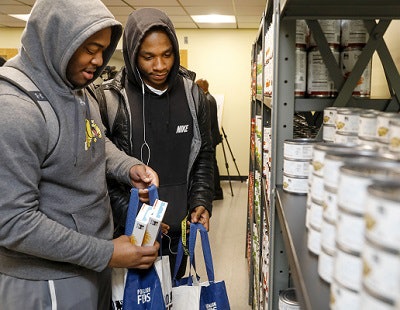When Bowie State University in Maryland announced this week that it is opening a food pantry on campus to provide free, nutritious food for students in need, it joined a growing number of higher education institutions around the country offering such services.
 Sharif Coombs (left) and David Medley at a food pantry at Bowie State University. Photo courtesy of Bowie State University.
Sharif Coombs (left) and David Medley at a food pantry at Bowie State University. Photo courtesy of Bowie State University.However, the Hope Center for College, Community and Justice released its 2019 #RealCollege survey findings this week, which found that despite such efforts, 39% of student respondents were food-insecure within 30 days prior of taking the survey. It also found that 46% of respondents were housing-insecure in the previous year and 17% were homeless at some time during the previous year.
In February 2013, the food pantry at the University of Massachusetts Boston (UMB) opened its doors with the initial goal of providing emergency grocery items to UMass Boston students who did not have access to food for balanced and healthy meals. But since then, the pantry has expanded into not just providing typical pantry items, but also fresh produce, toiletries and some school supplies. Any student enrolled for at least one credit is eligible to use the pantry, according to its website.
According to UMB program coordinator Valerie Lamour, the food pantry, with the help of its business and community partners, has enough supplies “to make an impact” but isn’t reaching as many students as possible. “Some students don’t feel comfortable coming to the office because there’s a lot of stigma involved with seeking out help,” Lamour told Diverse. She said their services also include housing referrals. “We try to connect students with the housing resources that are out there, though there are few, and we’re trying to come up with some sort of answer for emergency housing,” Lamour added.
Bowie State, an historically Black university, was scheduled to open its nutrition lounge this spring, but started early on a limited basis this week with plans to expand, according to university spokesperson Damita Chambers. It became the sixth school in the Food Lion Feeds Program, which also supports five other HBCU food pantries in North Carolina and Virginia.
“We know from our wellness center director that we have students who may have only one meal a day because that’s what their meal plan allows,” Chambers told Diverse. “The nutrition plan allows them to have healthy snacks between classes.” She also pointed out that the pantry provides toiletries and personal items as well as food.
According to the Hope Center #RealCollege survey report, “Until recently, few institutions identified basic needs insecurity as a significant challenge keeping students from obtaining credentials.” However, the report pointed out that, in 2018, the U.S. Government Accountability Office (GAO) issued a report on food insecurity among college students, stating that “increasing evidence indicates that some college students are experiencing food insecurity, which can negatively impact their academic success.”
The report stated that the #RealCollege survey was administered in the fall of 2019 at 227 two- and four-year institutions across the United States. It also considers the cumulative evidence on basic needs insecurity amassed over five surveys from 2015 to 2019. Overall, the information was obtained from more than 330,000 students attending 411 colleges and universities.
Specific findings included:
• Rates of food insecurity among students ranged from 42% to 56% at two-year institutions and from 33% to 42% at four-year institutions, with an overall weighted average of 43%.
• Rates of housing insecurity among students ranged from 46% to 60% at two-year institutions and from 35% to 48% at four-year institutions, with an overall weighted average of 48%.
• Rates of homelessness among students ranged from 12% to 18% at two-year institutions and from 9% to 16% at four-year institutions, with an overall weighted average of 16%.



















